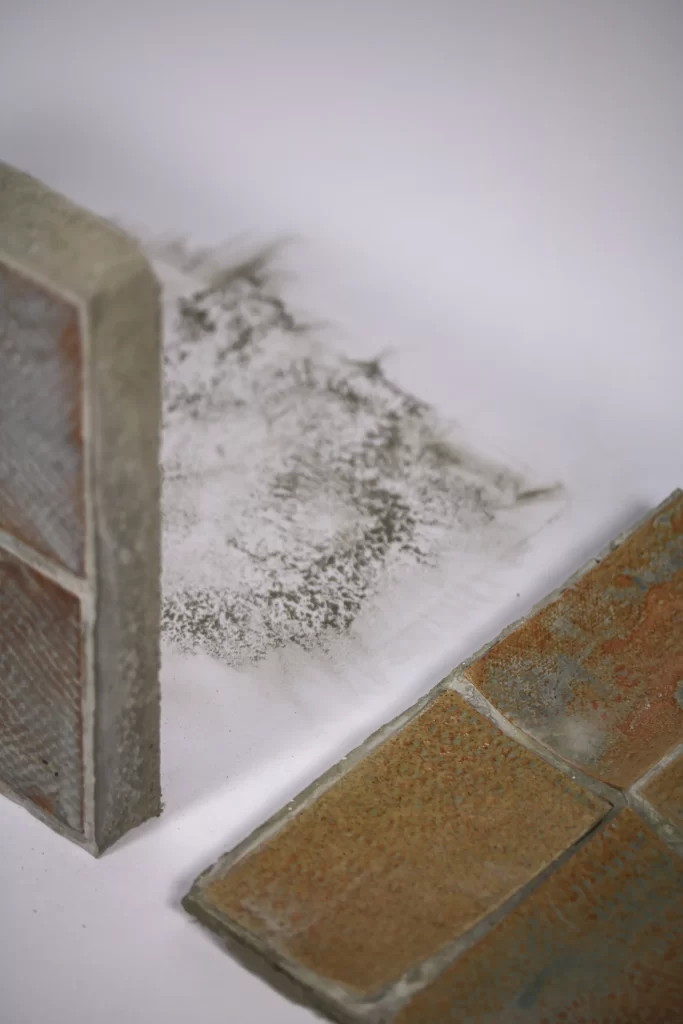A concern for material and craft was the motivation for this project. Buildings I encounter day-to-day are without reference to material, creating flat, boring and monotonous landscapes. Unloved buildings that lack authorship and material gesture are easily demolished and replaced. Boring buildings become much worse for the environment than interesting ones.
Architects are so far removed from the craftsmanship of making the buildings they design, the machine world is drowning the handmade. Prior to the Industrial Revolution, the master craftsman combined the roles of builder, craftsman, engineer and designer where creation of ideas was connected to the process of turning them into reality. Though there was a rich tradition of buildings that had evolved through centuries, utilising local skills, people, and materials, we were ready to throw it away for the industrialised model. As CAD became accessible, architects resigned to the screen, creating a disconnect between architecture and the raw materials from which it is built. Architecture is being designed without the influence of material. Against the perfection of the machine, the craftsman now represents human individuality, showcasing the variations, flaws, and irregularities in handwork.
As someone with an inclination to make things, this observation has led me to an investigation on the architectural meaning of material gesture and craft. Learning the language a material speaks, its intrinsic qualities and how that knowledge becomes translated to the scale of architecture. Architecture that represents craft and reveals the mark of its maker.
Using physical making as the primary method of design discovery, the thought processes of maker and material are in a continuous process of dialogue. Creativity emerges within a continuous improvisational process. To the mediaeval craftsman, there was no radical division between design and building, design was not placed before the work, both processes existed simultaneously.
Steel and clay are the two dominant materials explored here. Oddly similar where material can be added on and joints can be fused together. At first, these two are explored separately, then brought together through tests in crafting objects and furniture by hand at a 1:1 scale. While other materials were explored, developed investigations in steel and clay created a rich understanding of how materials act. Creating a library of knowledge on material and how its boundaries can be pushed to inform unique outcomes.
This process of design through handcraft was used to inform an architectural outcome, whereby the building becomes a culmination of material findings. Moving to an architectural scale implied the consideration of other constraints such as site and programme. A Newtown site and the prospect of an urban laneway prompted an urban investigation on how underused spaces can be activated. Looking at threshold, connectivity, amenity; these studies led to a masterplan that aimed to create multiple building typologies across the laneway, where periodic occupation becomes permanently woven into the site.
Materials used for the final design all reflect similar qualities. Steel sheet will patina over time, ceramic tiles hold a record of process – less imperfect than the handmade object. The scale and pattern of each aspect was chosen to reflect the art of the hand. Deciding which materials to use means considering what kind of making experiences become involved, as the act of making becomes dictated by material quality. The discovery of hydroformed, inflated steel and building of tile inset wall prototypes were both inquiries aimed at merging form, material and structure, where the formal qualities of steel and clay act to hold the building and give it structure – specifically the hydroformed ‘core’ centred in the ceramic studio – creating unity of design intent and structure rather than ornamentation.
A ceramics studio became the building programme, where every aspect of the design was influenced by prior material investigations. A circular way of thinking through making was applied to the design, where active materials answer to one another in the generation of form. The shared making space was influenced by my experience working in a ceramics studio as part of my design research. The plan and composition of the makers’ space came from the conscious tracing of movement within my patterns of working, moving through the space in a series of rituals in support of the way a potter might work.
When we make objects with our hands, we have no choice but to utilise the knowledge we have on material in order to design and understand how things are made. With mass manufacture and reliance on the machine, the hand is removed from this process of making; by default, the knowledge library of material contained within a craftsman’s hands becomes second to the machine. When design processes are linked to craftsmanship as two halves of a whole, the output forms a dialogue with its maker, where the practical conception of a design becomes the outworking of imaginative invention.

















